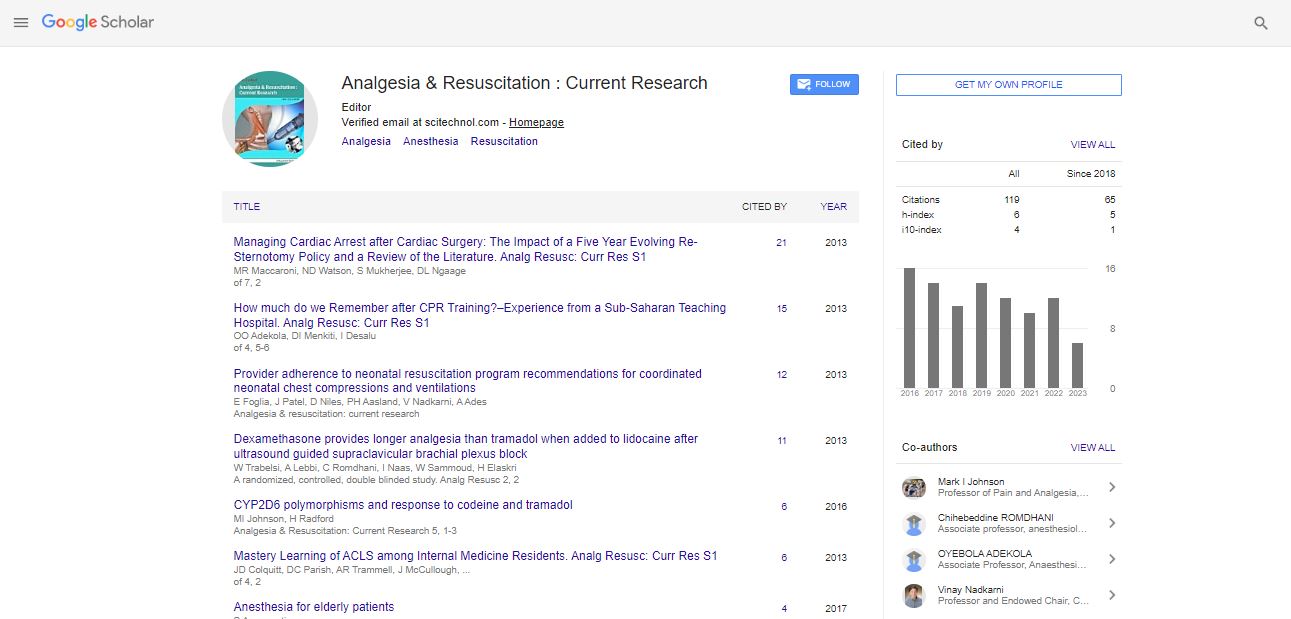Intervention approaches in management of neck pain among computer users
Balwinder Singh and Sonia Singh
Govt. College of Education, India
Punjabi University, India
: Analg Resusc: Curr Res
Abstract
The shift from manufacturing and resource-based jobs to the service industry has transformed the nature of work injuries and disability. The high rate of acute and fatal injuries observed in most countries at the beginning of the 20th century has been replaced by a sharp increase in the incidence of compensated musculoskeletal disorders such as back and neck pain. Neck pain is a major problem among computer users which causes considerable personal suffering due to pain, disability, and impaired quality of life, inducing great socioeconomic burden on both patients and society. Computer related health problems if ignored can prove debilitating. Therefore, there is a need to understand the dynamics of these problems and prevent it from assuming epidemic proportion. In this line of thought, the present study was done with an aim to find an appropriate physical intervention for management of neck pain among computer users. A total of 60 computer users with a history neck pain, who satisfied the inclusion criteria, were randomly assigned to three intervention groups; Group A ( Conventional physiotherapy), Group B (Muscle Energy Technique and conventional physiotherapy) and Group C (Microwave diathermy, Muscle Energy Technique and conventional physiotherapy). All the interventions were given thrice a week for a period of 4 weeks. Clinical tests including VAS scale and Neck disability index (NDI) were used to assess the post intervention outcomes. Results of the within group analysis (paired t test) indicated significant improvement in all the three intervention groups for both the outcomes; VAS (t= 6.2, 14.12, 19.9 respectively for the Group A, B and C).), NDI (t=10.8, 10.7, 14.9 respectively in Group A, B and C) at p≤ 0.05. Findings of the inter group comparison (one way ANOVA) suggested a statistically significant difference among the three interventions groups with f= 29.46, 36.51 at p≤ 0.05 for VAS and NDI respectively. Further comparisons were done using Tukey’s Kramer post hoc test. The results indicated that intervention C (Microwave diathermy plus Muscle energy technique and conventional) was the most effective intervention amongst the three interventions for decreasing the neck disability (NDI). However in reference to pain (VAS), intervention B and C proved to be equally but significantly more effective than the intervention A (conventional physiotherapy). Thus it is concluded that Microwave diathermy and MET when added to the conventional physiotherapy programs may enhance the effectiveness of the protocol in reference to neck pain and disability.
Biography
Balwinder Singh has done Masters in Mathematics and Master in Computer Applications from Guru Nanak Dev University, Amritsar. He has more than 22 years of teaching experience and presently working as Associate Professor Computer Science at Govt. College of Education, Patiala one of the premier institute of education in North India. His thrust areas of research are impact of ICT in teaching learning process. He has published more than 10 papers in reputed National Journals, one paper in the International Journal and presented more than 20 papers in National/ Regional level conferences/ seminars. He has authored a text book entitled “Computer Education” for BEd and MEd students. Sonia Singh is presently working as Assistant Professor in the department of physiotherapy, Punjabi University, Patiala. She has done her post graduation in the field of musculoskeletal physiotherapy and PhD in the field of geriatrics. She has a total of 10 years teaching and research experience at both undergraduate and post graduate levels. She has guided a total of eighteen research projects to the post graduate students in physiotherapy. She has seven international and seven national research paper publications and a book published in her credit.
 Spanish
Spanish  Chinese
Chinese  Russian
Russian  German
German  French
French  Japanese
Japanese  Portuguese
Portuguese  Hindi
Hindi 
